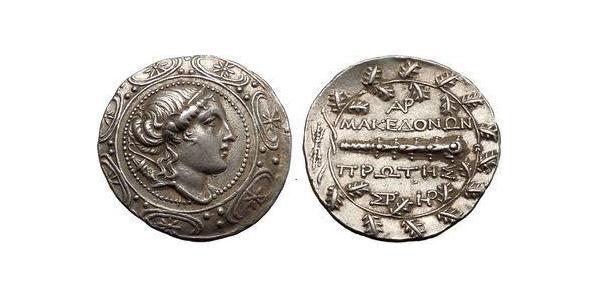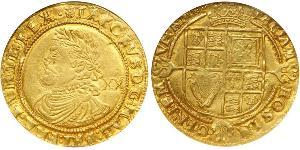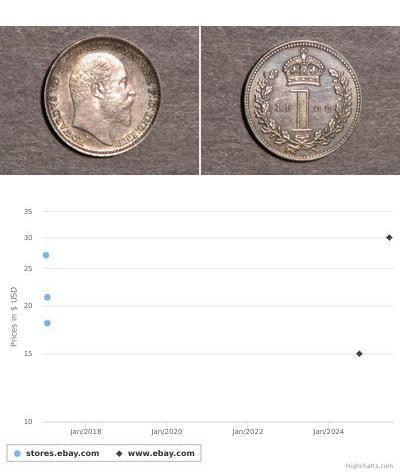[ 5488] MACEDONIA: AMPHIOPOLIS Silver Tetradrachm (35mm, 16.93 gm.) Struck 158-150 B.C. Reference: S. 56. SNG Cop. 1312. AMNG III 1. Macedonian shield, at center of which but of Artemis Tauropolos right; bow and quiver at her shoulder. MAKEΔONΩΝ / ΠΡΩΤΗΣ above and below club right; in field above, monogram; all within oak-wreath, to left of which, thunderbolt. From the reopening of the silver mines to the revolt of Andriscus. Founded by Athenians in 436 B.C. to protect their mining interests in the north, Amphipolis surrendered to the Spartan general Brasidas in 424. The city preserved its independence until 357 when it was captured by Philip II, King of Macedon. Provided with certificate of authenticity. CERTIFIED AUTHENTIC by Sergey Nechayev, PhD - Numismatic Expert Artemis Tauropolos in ancient Greece, was an epithet for the goddess Artemis, variously interpreted as worshipped at Tauris, or pulled by a yoke of bulls, or hunting bull goddess. A statue of Artemis "Tauropolos" in her temple at Brauron in Attica was supposed to have been brought from the Taurians by Iphigenia. Tauropolia was also a festival of Artemis in Athens. There was a Tauropolion, a temple in a temenos sacred to Artemis Tauropolos, in the north Aegean island of Doliche (now Ikaria). Artemis was one of the most widely venerated of the Ancient Greek deities. Some scholars believe that the name, and indeed the goddess herself, was originally pre-Greek. Homer refers to her as Artemis Agrotera, Potnia Theron < Artemis of the wildland, Mistress of Animals". In the classical period of Greek mythology, Artemis (Greek: (nominative) Ἄρτεμις, (genitive) Ἀρτέμιδος) was often described as the daughter of Zeus and Leto, and the twin sister of Apollo. She was the Hellenic goddess of the hunt, wild animals, wilderness, childbirth, virginity and young girls, bringing and relieving disease in women; she often was depicted as a huntress carrying a bow and arrows. The deer and the cypress were sacred to her. In later Hellenistic times, she even assumed the ancient role of Eileithyia in aiding childbirth. Artemis later became identified with Selene, a Titaness who was a Greek moon goddess, sometimes depicted with a crescent moon above her head. She was also identified with the Roman goddess Diana, with the Etruscan goddess Artume, and with the Greek or Carian goddess Hecate. Amphipolis was an ancient Greek city in the region once inhabited by the Edoni people in the present-day periphery of Central Macedonia. It was built on a raised plateau overlooking the east bank of the river Strymon where it emerged from Lake Cercinitis, about 3 m. from the Aegean Sea. Founded in 437 BC, the city was finally abandoned in the 8th century AD. The present municipality Amfipoli, named after the ancient city, occupies the site. Currently, it is a municipality in the Serres Prefecture, Central Macedonia with a population of 3,623 (2001 census). Origins Archaeology has uncovered remains at the site dating to approximately 3000 BC. Due to the strategic location of the site it was fortified from very early. Xerxes I of Persia passed during his invasion of Greece of 480 BC and buried alive nine young men and nine maidens as a sacrifice to the river god. Near the later site of Amphipolis Alexander I of Macedon defeated the remains of Xerxes' army in 479 BC. Throughout the 5th century BC, Athens sought to consolidate its control over Thrace, which was strategically important because of its primary materials (the gold and silver of the Pangaion hills and the dense forests essential for naval construction), and the sea routes vital for Athens' supply of grain from Scythia. After a first unsuccessful attempt at colonisation in 497 BC by the Miletian Tyrant Histiaeus, the Athenians founded a first colony at Ennea-Hodoi (‘Nine Ways’) in 465, but these first ten thousand colonists were massacred by the Thracians. A second attempt took place in 437 BC on the same site ...
Mehr...

|
Beigetragen von:
anonymous 2015-08-18 |
Similar Coin Groups

1 Stiver Republik der Sieben Vereinigten ...
Diese Gruppe hat 9 Münzen / 9 Preise
Add coin to this group
2025-06-04
- Echtzeit Münzkatalog Verbesserungen / Münz-Gruppierung
44 coins were grouped from 2025-05-28 to 2025-06-04
Eine von ihnen ist:
1 Rubel Russisches Reich (1720-1917) Silber
Diese Gruppe hat 12 Münzen / 12 Preise
⇑
1 рубль 1912 года. АГ-АГ-(ЭБ). Серебро, 20,02 г. Чеканен по случаю открытия памятника Александр ...
2025-06-14
- Historical Coin Prices
Das könnte Sie auch interessieren:













-300-150-72sKbzbis7EAAAFPBUQ1Mk0C.jpg)
-300-150-9UEKbzbiU5UAAAFQcX3krksT.jpg)






